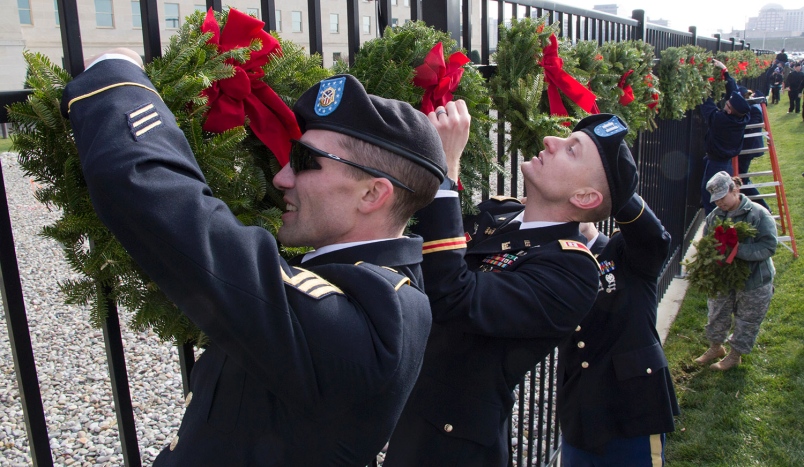By Carlos Bongioann, Stars & Stripes
Volunteers fanned out across Arlington National Cemetery Saturday to place 143,000 balsam remembrance wreaths on the graves of America’s fallen as the Wreaths across America program marked its 22nd year.

Service members join civilian volunteers in placing wreaths on a fence at the National 9/11 Pentagon Memorial in Arlington, Va., as part of Wreaths across America
Joe Gromelski Stars & Stripes
ARLINGTON, Va. — Kathy Dillaber, who survived the September 1, 2001, terrorist attack on the Pentagon that killed her sister helped hang the first of 184 wreaths placed in memory of those who died there that day.
The ceremony Friday at the Pentagon Memorial was the first of several planned across the country and overseas as part of Wreaths across America. On Saturday, thousands of volunteers turned out to lay more than 200,000 wreaths on graves at Arlington National Cemetery.
“I was fortunate that I was able to get out of the building. Too many good people didn’t,” said Dillaber, a retired Army civilian who recalled how her “baby sister,” Patty Mickley, another DOD civilian, as well as 24 coworkers from her Army personnel office died when a hijacked plane was flown into the building.
Dillaber, who now volunteers as a docent at the 9/11 Pentagon Memorial, said her duties of explaining to visitors the significance of the attacks helps her come to terms with the tragedy. It gives her the opportunity to regularly honor her family, both her “blood family and work family that are no longer here,” she said.
Joining Dillaber in hanging the first wreath were Wreaths Across America founder Morrill Worcester and Jim Laychak, president of the National 9/11 Pentagon Memorial Fund.
Laychak praised Wreaths across America for giving “a great gift” to the families of those who died in the attacks 13 years ago. His brother, David Laychak, an Army civilian, was among them.
“That gift is not forgetting our loved ones and helping others never to forget what happened,” Laychak said.
During Friday’s ceremony, Katherine Hammack, the assistant secretary of the Army for Installations, energy and environment, talked of the picture that hangs on the wall of her office on the third floor on the E ring where the plane hit. The picture of a huge black hole reminds her every day what her office building looked like after the attack.
“We will not forget the profound loss of the 59 people on that plane or the 125 who were in the Pentagon,” Hammack said, “our colleagues whose lives were cut short that day.”
On Saturday, Gov. Paul LePage and his wife, Ann, led a large contingent of Maine residents to Arlington for the wreath-laying event.
“Their mission statement — to remember the fallen, honor those that served and teach our children — really is my driving force to do what I do for our military servicemembers in Maine,” said Ann LePage, the wife of Maine Gov. Paul LePage. “I think that in just about every speech that I give in Maine I’ve said something about Wreaths Across America. I just believe in it so much, and I think it’s so good for this country.”
Mrs. LePage again made the trip from Maine on a three-wheeled motorcycle.
“We come down every year,” said the governor, adding that “I take the more traditional way to get down here.”
The tradition of honoring those buried at Arlington with holiday wreaths dates back to 1992 when Worcester Wreath Company in Harrington, Maine, found itself with a surplus of wreaths. Morrill Worcester, the owner, donated the wreaths to the national cemetery at Arlington and then decided to keep doing it. The practice continued quietly for 14 years, until word of the venture spread, drawing the interest of others who wanted to participate.
In 2006, the company began getting requests to lay wreaths at sites all over the country. The size and scope of the holiday project became so large that the Worcesters in 2007 formed the Wreaths across America non-profit. By 2010, the organization, along with a host of volunteers, laid more than 220,000 wreaths at 545 locations in the United States and overseas.
Karen Worcester, Morrill Worcester’s wife and executive director of Wreaths across America, said the concept of America’s heritage of freedom was like a torch. “When that plane flew into this building, we all gathered around, and we fueled the torch. But a few years later, it started to dim.”
“Laying the wreaths gives us something tangible to come together to do, to bring us closer together,” she said. “But the real thing that we need to do is to keep that in our hearts every day” for generations to come.

